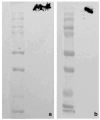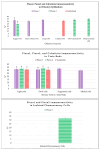Piezo 1 and Piezo 2 in the Chemosensory Organs of Zebrafish (Danio rerio)
- PMID: 39000511
- PMCID: PMC11242578
- DOI: 10.3390/ijms25137404
Piezo 1 and Piezo 2 in the Chemosensory Organs of Zebrafish (Danio rerio)
Abstract
The ion channels Piezo 1 and Piezo 2 have been identified as membrane mechano-proteins. Studying mechanosensitive channels in chemosensory organs could help in understanding the mechanisms by which these channels operate, offering new therapeutic targets for various disorders. This study investigates the expression patterns of Piezo proteins in zebrafish chemosensory organs. For the first time, Piezo protein expression in adult zebrafish chemosensory organs is reported. In the olfactory epithelium, Piezo 1 immunolabels kappe neurons, microvillous cells, and crypt neurons, while Calretinin is expressed in ciliated sensory cells. The lack of overlap between Piezo 1 and Calretinin confirms Piezo 1's specificity for kappe neurons, microvillous cells, and crypt neurons. Piezo 2 shows intense immunoreactivity in kappe neurons, one-ciliated sensory cells, and multi-ciliated sensory cells, with overlapping Calretinin expression, indicating its olfactory neuron nature. In taste buds, Piezo 1 immunolabels Merkel-like cells at the bases of cutaneous and pharyngeal taste buds and the light and dark cells of cutaneous and oral taste buds. It also marks the dark cells of pharyngeal taste buds and support cells in oral taste buds. Piezo 2 is found in the light and dark cells of cutaneous and oral taste buds and isolated chemosensory cells. These findings provide new insights into the distribution of Piezo channels in zebrafish chemosensory organs, enhancing our understanding of their sensory processing and potential therapeutic applications.
Keywords: Piezo 1; Piezo 2; isolated chemosensory cells; olfactory epithelium; sensory organ; taste buds; translational medicine; zebrafish.
Conflict of interest statement
The authors declare no conflicts of interest.
Figures








Similar articles
-
Localization of Piezo 1 and Piezo 2 in Lateral Line System and Inner Ear of Zebrafish (Danio rerio).Int J Mol Sci. 2024 Aug 24;25(17):9204. doi: 10.3390/ijms25179204. Int J Mol Sci. 2024. PMID: 39273152 Free PMC article.
-
Localization of BDNF and Calretinin in Olfactory Epithelium and Taste Buds of Zebrafish (Danio rerio).Int J Mol Sci. 2022 Apr 23;23(9):4696. doi: 10.3390/ijms23094696. Int J Mol Sci. 2022. PMID: 35563087 Free PMC article.
-
Differential distribution of S100 protein and calretinin in mechanosensory and chemosensory cells of adult zebrafish (Danio rerio).Brain Res. 2007 Aug 8;1162:48-55. doi: 10.1016/j.brainres.2007.05.070. Epub 2007 Jun 15. Brain Res. 2007. PMID: 17618610
-
Acid-sensing ion channels and transient-receptor potential ion channels in zebrafish taste buds.Ann Anat. 2016 Sep;207:32-7. doi: 10.1016/j.aanat.2016.06.006. Epub 2016 Aug 8. Ann Anat. 2016. PMID: 27513962 Review.
-
Hedgehog Signaling Regulates Taste Organs and Oral Sensation: Distinctive Roles in the Epithelium, Stroma, and Innervation.Int J Mol Sci. 2019 Mar 16;20(6):1341. doi: 10.3390/ijms20061341. Int J Mol Sci. 2019. PMID: 30884865 Free PMC article. Review.
Cited by
-
Piezo1/2 regulates gastric pepsinogen secretion of mandarin fish.Fish Physiol Biochem. 2025 May 15;51(3):97. doi: 10.1007/s10695-025-01512-z. Fish Physiol Biochem. 2025. PMID: 40372577
-
Development of an rpS6-Based Ex Vivo Assay for the Analysis of Neuronal Activity in Mouse and Human Olfactory Systems.Int J Mol Sci. 2024 Dec 7;25(23):13173. doi: 10.3390/ijms252313173. Int J Mol Sci. 2024. PMID: 39684883 Free PMC article.
-
Ion-Channel Proteins in the Prepubertal Bitch Reproductive System: The Immunolocalization of ASIC2, ASIC4, and PIEZO2.Int J Mol Sci. 2025 May 5;26(9):4388. doi: 10.3390/ijms26094388. Int J Mol Sci. 2025. PMID: 40362625 Free PMC article.
-
Molecular Insights Into the Sensory Adaption of the Cave-Dwelling Leech Sinospelaeobdella wulingensis to the Karst Cave Environment.Ecol Evol. 2025 Jan 18;15(1):e70877. doi: 10.1002/ece3.70877. eCollection 2025 Jan. Ecol Evol. 2025. PMID: 39839334 Free PMC article.
-
Localization of Piezo 1 and Piezo 2 in Lateral Line System and Inner Ear of Zebrafish (Danio rerio).Int J Mol Sci. 2024 Aug 24;25(17):9204. doi: 10.3390/ijms25179204. Int J Mol Sci. 2024. PMID: 39273152 Free PMC article.
References
-
- Bhattarai P., Cosacak M.I., Mashkaryan V., Demir S., Popova S.D., Govindarajan N., Brandt K., Zhang Y., Chang W., Ampatzis K. Neuron-glia interaction through Serotonin-BDNF-NGFR axis enables regenerative neurogenesis in Alzheimer’s model of adult zebrafish brain. PLoS Biol. 2020;18:e3000585. doi: 10.1371/journal.pbio.3000585. - DOI - PMC - PubMed
MeSH terms
Substances
LinkOut - more resources
Full Text Sources
Molecular Biology Databases

